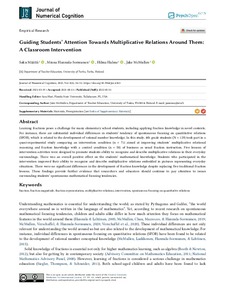Guiding Students’ Attention Towards Multiplicative Relations Around Them: A Classroom Intervention
Määttä Saku; Hannula-Sormunen Minna; Halme Hilma; McMullen Jake
https://urn.fi/URN:NBN:fi-fe2022081154406
Tiivistelmä
Learning fractions poses a challenge for many elementary school students, including applying fraction knowledge in novel contexts. For instance, there are substantial individual differences in students’ tendency of spontaneous focusing on quantitative relations (SFOR), which is related to the development of rational number knowledge. In this study, 4th grade students (N = 129) took part in a quasi-experimental study comparing an intervention condition (n = 71) aimed at improving students’ multiplicative relational reasoning and fraction knowledge with a control condition (n = 58) of business as usual fraction instruction. Five lessons of intervention activities were designed to promote students ability to recognize and describe multiplicative relations in their everyday surroundings. There was an overall positive effect on the students’ mathematical knowledge. Students who participated in the intervention improved their ability to recognize and describe multiplicative relations embedded in pictures representing everyday situations. There were no significant differences in the development of fraction knowledge despite replacing five traditional fraction lessons. These findings provide further evidence that researchers and educators should continue to pay attention to issues surrounding students’ spontaneous mathematical focusing tendencies.
Kokoelmat
- Rinnakkaistallenteet [27094]
